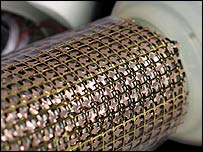
The "skin" can sense temperature and pressure simultaneously
|
Japanese researchers have developed a flexible artificial skin that could give robots a humanlike sense of touch.
The team manufactured a type of "skin" capable of sensing pressure and another capable of sensing temperature.
These are supple enough to wrap around robot fingers and relatively cheap to make, the researchers have claimed.
The University of Tokyo team describe their work in the latest issue of the journal Proceedings of the National Academy of Sciences.
The researchers explain how pressure-sensing and temperature-sensing networks can be laminated together, forming an artificial skin that can detect both properties simultaneously.
Takao Someya, lead author on the latest research, previously developed a form of artificial skin capable of sensing pressure.
But the ability to sense temperature as well allows the scientists to more closely imitate the functions of human skin.
Someya and his colleagues used electronic circuits as pressure sensors and semiconductors as temperature sensors. They embedded these sensors in a thin plastic film to create a net-like matrix.
Organic materials
The transistors used in the circuits and the semiconductors both use "organic" materials based on chains of carbon atoms.
This makes them mechanically flexible and relatively inexpensive to fabricate.
"Both of those characteristics sound compelling. The material sounds like it could have lots of functions," Dr Douglas Weibel, of the department of chemistry and chemical biology at Harvard University told the BBC News website.
"The materials they're using may not be completely novel but the integration appears to be something new."
The University of Tokyo scientists say their breakthrough has the potential to improve how robots will function in the real world.
And they add that there is no need to stop at simply imitating the functions of human skin.
"It will be possible in the near future to make an electronic skin that has functions that human skin lacks," the researchers write in Proceedings of the National Academy of Sciences.
Future artificial skins could incorporate sensors not only for pressure and temperature, but also for light, humidity, strain or sound, they add.
